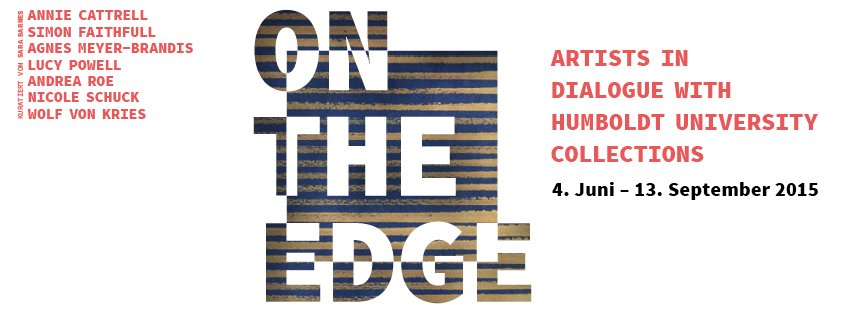
Organisers: Sara Barnes, Jochen Hennig, Felix Sattler (Hermann von Helmholtz-Zentrum für Kulturtechnik / Excellence Cluster Image Knowledge Gestaltung. An Interdisciplinary Laboratory; Humboldt-Universität zu Berlin)
The workshop aims to reflect, contextualise and amplify the exhibition »On the Edge. Artists in Dialogue With the Humboldt University Collections« at the Tieranatomisches Theater (June 3rd – September 12th , 2015). Curated by Sara Barnes, seven international artists investigate the unstable status of objects between application/utiliy and historical value and probe the migration between collection and exhibition space.
The exhibition and the workshop act on the assumption that exhibitions produce knowledge by aesthetic means. The relation of protagonists involved – scientists, artists, gestalter, exhibition curators and collection custodians – has been in a constant state of flux since the late 1970s. The workshop aims to retrace these shifts and to reflect on the exhibition »On the Edge« as an example of this transformation.
The programme is divided into four sections:
Collection Aesthetics
Artists, Gestalter, curators but also scientists are involved with the aesthetical dimension of collections. Thereby the interest in a specific aesthetic of collections differs from investigating certain objects or collections as a whole. Collections are always more than the sum of its objects, but only very few things are typically and exclusively regarded as collection objects, such as taxidermic preparations, archaeological artifacts and certain scientific models etc.
This panel will question and discuss an aesthetic that is original and specific to collections, for example, how scientists, curators and artists approach the seriality of collection objects: with spatial distributions of objects or with selection processes.
Artist Residencies
In the past two decades, artist-in-residence programmes have exceeded their traditional institutional connections with museums of (contemporary) art or art centres. Many cultural and natural history museums, for example, have been installing artist-in-residence programmes and universities have followed soon after. Some programmes give artists an opportunity to work with collections as “raw material” and use scientific infrastructures such as laboratories in order to create new work. Other residencies are specifically designed to foster institutional critique, that is, to involve artists in institutional and collection practice, questioning traditional taxonomy and strategies of display.
The panel will discuss the potential of artist-in-residence programmes for both artists and institutions alike. What kind of knowledge transfer can be made possible between scientist and artists? Which conditions should be provided by the institution? Which kind of knowledge is required by artists in terms of academic culture, infrastructure, collections and objects?
Gestaltung and Art in aesthetical knowledge production
While artists working with collections are usually bound to create a distinct, separate body of their own work, »Gestaltung« is usually referred to in its role of supporting scientific and curatorial presentation. This panel questions the specifics of art contributions to scientific collections and if Gestaltung can be more than staging, that is, if Gestaltung can be regarded as an »operational« practice that continuously transforms objects and the knowledge about them.
This determination of art and Gestaltung leads to the question of the relationship between both these domains of aesthetical knowledge production within »knowledge exhibitions«, especially since currently these approaches generally appear as alternative, but not as complementary approaches.
Change of Constellations
Since the 1970s, the boundaries between the parties involved in the
making of exhibitions – scientist, collection custodian, exhibition
curator, architect, designer and artist – have become blurred or
permeable and sometimes entirely disappeared. The traditional role of
the curator as a custodian of certain collections has shifted. The
display of knowledge of a single area of expertise has been supplemented
by interdisciplinary approaches leading to new kinds of themed
exhibitions. In even more recent years, the history and formation of
knowledge in museums has become a main interest of museological practice
and became part of »knowledge exhibitions«.
The panel aims to retrace these developments and questions the present
identity and responsibilities of museum, exhibition and collection
professionals.
Wednesday, 5 – 7 p.m. (in German language)
Introduction
Collection Aesthetics
- Prof. Dr. Horst Bredekamp (History of Art, Humboldt-Universität zu Berlin)
- Prof. Dr. Gerhard Scholtz (Biology, Humboldt-Universität zu Berlin)
- Moderation: Dr. Jochen Hennig
Thursday, 9.30 a.m. – 3.45 p.m. (in English language)
9.30 – 10.55 a.m.
Introduction
Artist Residencies at Universities
- Prof. Dr. Regine Hengge (Biology, Humboldt-Universität zu Berlin)
- Nicole Schuck (Artist, Berlin)
- Moderation: Dr. Sara Barnes
11.15 a.m. – 12.30 p.m.
Gestaltung and Art in aesthetical knowledge production
- Dr. Petra Lange-Berndt (History of Art, University College London)
- Prof. Dr. Wolfgang Schäffner (Cultural Theory and History, Humboldt-Universität zu Berlin)
- Moderation: Felix Sattler
2 – 3.15 p.m.
Change of Constellations
- Prof. Dr. Anke te Heesen (History of Science, Humboldt-Universität zu Berlin)
- Anna-Sophie Springer (Curator, Berlin)
- Moderation: Dr. Jochen Hennig
3.15 – 3.45 p.m.

